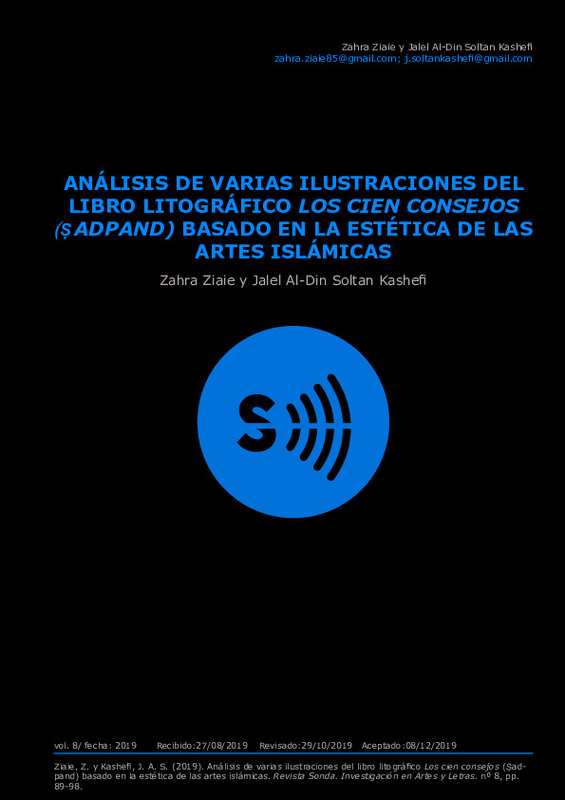|
Resumen:
|
[EN] The One Hundred Advices Lithographic Book,
published in 1905, is a collection of translations of
hundreds of moral narratives of Mirzā Ali Asğar Jan
Piš Jedmat, written in Persia during the monarchy
of Moẓaffar-Al-Din ...[+]
[EN] The One Hundred Advices Lithographic Book,
published in 1905, is a collection of translations of
hundreds of moral narratives of Mirzā Ali Asğar Jan
Piš Jedmat, written in Persia during the monarchy
of Moẓaffar-Al-Din Šāh Qāŷār
. The book contains
nineteen illustrations and does not refer to the name
of its illustrator and its compiler. The purpose of this
article is to review and study some of illustrations
lithography
based on the principles and rules of the
great tradition of Persian painting, such as advise in
the form, the avoid of vacuum, the elimination of
perspectives, the chiaroscuro and the representation
of the dimension, because there is no exhaustive
research on the illustrations in this book. This
research is developed from the following questions:
Is the form related to the topic and content? What
are the causes of the lack of color?, What are the
reasons for the impoverishment of Islamic art in
lithography? At the end of this investigation it is
concluded that the illustration has an immediate link
with the literature and that the technical limitations
of this form of printing did not allow the use of color
and therefore transmit the impact of the pictorial
language of the West as a result of the close links
with Europe, with the result of the impoverishment
of Islamic art in lithographic illustrations. In
addition, it is worth mentioning that this book
contains valuable illustrations with lithographic
technique, therefore it can be considered as a suitable platform for historical studies of Qāŷār art.
Studying the illustrations is done based on Islamic
art aesthetics approach in the article because it has
a direct relationship with Persian painting and the
given aesthetics. Descriptive-analytical method is
used for the research and library resources are used
for data gathering.
[-]
[ES] El libro litográfico Los Cien consejos, impreso en
1905, es una colección de traducciones de cien narraciones morales compiladas y traducidas al persa por Mirzā Ali Asğar Jan Piš Jedmat, durante la
monarquía de ...[+]
[ES] El libro litográfico Los Cien consejos, impreso en
1905, es una colección de traducciones de cien narraciones morales compiladas y traducidas al persa por Mirzā Ali Asğar Jan Piš Jedmat, durante la
monarquía de Moẓaffar-Al-Din Šāh Qāŷār. El libro contiene diecinueve ilustraciones (litografías) y
en él no hay referencia alguna ni al ilustrador ni al
autor de dichos consejos. El propósito del presente
artículo es un estudio de las algunas ilustraciones
que contiene la citada litografía
desde la tradición
pictórica de la pintura persa analizando diferentes
aspectos como el tratamiento de la forma, el horror
vacui, la eliminación de perspectivas y la representación de la dimensión y el claroscuro, porque no hay
una investigación exhaustiva sobre las ilustraciones
de este libro. Esta investigación se desarrolla a partir
de las siguientes preguntas: ¿Está la forma relacionada con el tema y el contenido?, ¿cuáles son las
causas de la falta del color?, ¿cuáles son las razones
del empobrecimiento del arte islámico en la litografía? Al final de esta investigación se concluye que la
ilustración tiene un vínculo inmediato con la literatura y que las limitaciones técnicas de esta forma
de impresión no permitieron utilizar el color y por
tanto transmitir el impacto del lenguaje pictórico de
Occidente como fruto de los estrechos vínculos con
Europa con el resultado del empobrecimiento del
arte islámico en las ilustraciones litográficas. Además, cabe mencionar que este libro contiene valiosas ilustraciones con técnica litográfica, por lo que
puede considerarse una plataforma adecuada para
los estudios históricos del arte de la época Qāŷār. El
estudio de las ilustraciones se realiza en base al enfoque de la estética de las artes islámicas porque tiene una relación directa con la pintura persa y su
estética. El método descriptivo-analítico se utiliza
para la investigación y los recursos de la biblioteca
se utilizan para la recopilación de datos.
[-]
|








